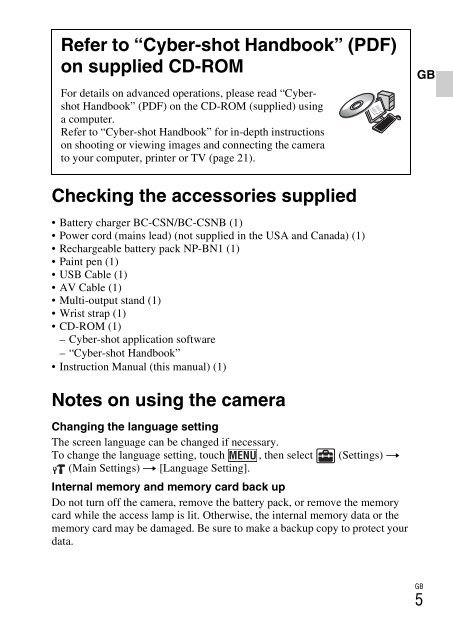Sony DSC-TX9 - DSC-TX9 Istruzioni per l'uso Portoghese
Sony DSC-TX9 - DSC-TX9 Istruzioni per l'uso Portoghese
Sony DSC-TX9 - DSC-TX9 Istruzioni per l'uso Portoghese
You also want an ePaper? Increase the reach of your titles
YUMPU automatically turns print PDFs into web optimized ePapers that Google loves.
Functions built into this camera<br />
• This manual describes each of the functions of TransferJet-compatible/<br />
incompatible devices, 1080 60i-compatible devices and 1080 50i-compatible<br />
devices.<br />
To check if your camera supports the TransferJet function, and whether it is<br />
a 1080 60i-compatible device or 1080 50i-compatible device, check for the<br />
following marks on the bottom of the camera.<br />
TransferJet-compatible device: (TransferJet)<br />
1080 60i-compatible device: 60i<br />
1080 50i-compatible device: 50i<br />
• Do not watch 3D images shot with this camera for extended <strong>per</strong>iods of time<br />
on 3D-compatible monitors.<br />
• When you view 3D images shot with this camera on a 3D-compatible<br />
monitors, you may ex<strong>per</strong>ience discomfort in the form of eye strain, fatigue,<br />
or nausea. To prevent these symptoms, we recommend that you take regular<br />
breaks. However, you need to determine for yourself the length and<br />
frequency of breaks you require, as they vary according to the individual. If<br />
you ex<strong>per</strong>ience any type of discomfort, stop viewing the 3D images until you<br />
feel better, and consult a physician as necessary. Also refer to the o<strong>per</strong>ating<br />
instructions supplied with the device or software you have connected or are<br />
using with this camera. Note that a child’s eyesight is still at the development<br />
stage (particularly children below the age of 6). Consult a pediatrician or<br />
ophthalmologist before letting your child view 3D images, and make sure he/<br />
she observes the above precautions when viewing such images.<br />
On database files<br />
When you insert a memory card without a database file into the camera and<br />
turn on the power, part of the memory card capacity is used to automatically<br />
create a database file. It may take some time until you can <strong>per</strong>form the next<br />
o<strong>per</strong>ation.<br />
GB<br />
6<br />
Notes on recording/playback<br />
• To ensure stable o<strong>per</strong>ations of the memory card, we recommend that you use<br />
this camera to format any memory card being used with this camera for the<br />
first time. Note that formatting will erase all data recorded on the memory<br />
card. This data cannot be restored. Be sure to backup any important data to a<br />
PC or other storage location.<br />
• If you repeatedly record/delete images, fragmentation of data may occur on<br />
the memory card. Movies may not be able to be saved or recorded. In such a<br />
case, save your images to a PC or other storage location, then [Format].<br />
• Before you start recording, make a trial recording to make sure that the<br />
camera is working correctly.<br />
• The camera is neither dust-proof, nor splash-proof, nor water-proof.<br />
• Avoid exposing the camera to water. If water enters inside the camera, a<br />
malfunction may occur. In some cases, the camera cannot be repaired.
















